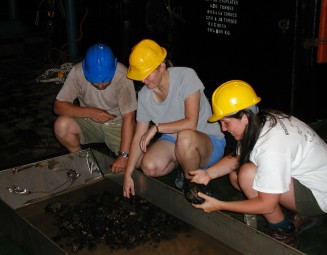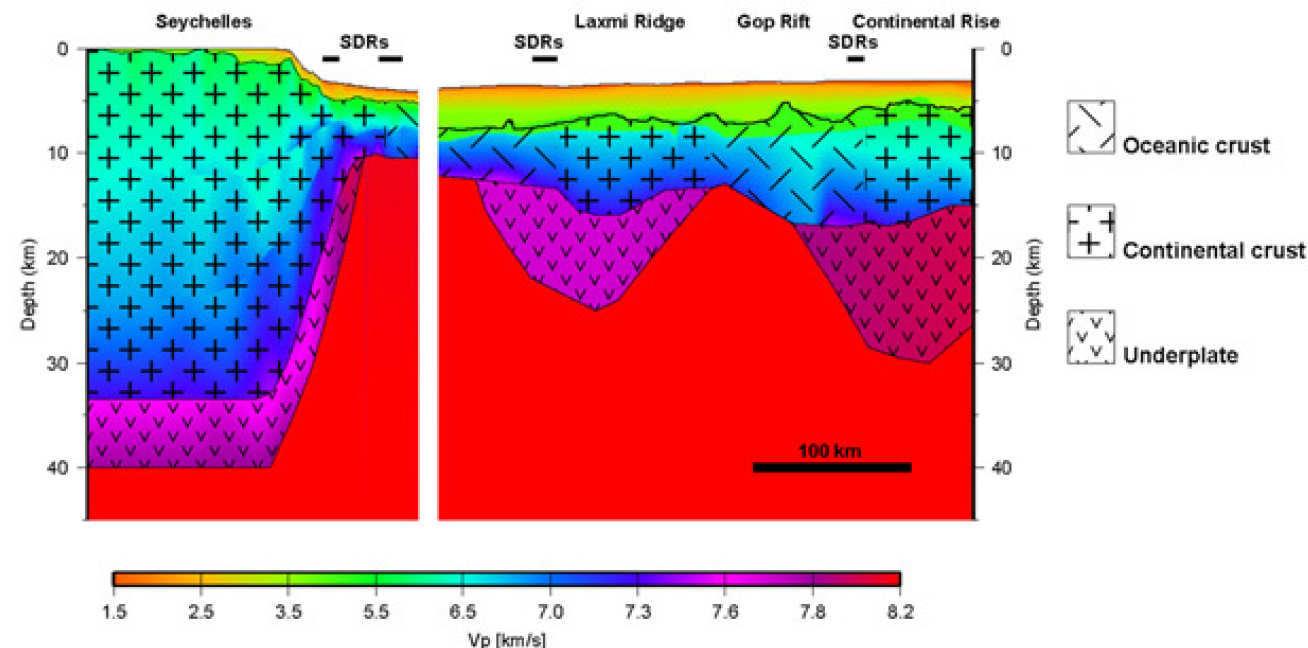The structure of the conjugate Seychelles/Indian passive margins

This research focussed on the relationships between magmatism and extension at rifted margins. When a continent breaks apart it does so with either massive outpouring of magma or hardly any at all. The consensus among scientists before our work was that these very different styles of breakup are controlled by the temperature of the mantle beneath the separating continents; however the number of places studied was limited. This project aimed to adress this defficiency by collecting new data in the Indian Ocean. We conducted three oceanographic cruises during which an extensive set of gravity, magnetic, seismic and dredge samples were collected (Fig.1). The active source programme was followed by a year-long passive seismic deployment.
The Seychelles-Indian margins had been widely cited as a classic example of rifting above hot mantle. However we did not find the typical set of geophysical characteristics reported at other margins linked to continental flood basalts, such as those of the north Atlantic. The oceanic crust formed immediately after break-up and throughout the first 3 Ma of seafloor spreading is just 5.2 km thick, less than half that typically seen at other volcanic margins (Fig.2). The continent-ocean transition zone is narrow and whilst two packages of seaward-dipping-reflectors are imaged within this transition they are weakly developed. Beneath the thinned continental crust there is an approximately 4 km thick layer of high-P-wave-velocity material (7.5-7.8 km/s) that we interpret as mafic material intruded and underplating the lower crust. On the Indian side of the breakup we found a second rift, with thick oceanic crust below the Gop Rift separating the Laxm Ridge continental fragment from India.

Given the potential significance of these results we conducted a numerical modelling study and showed that the volume of rift-related magmatism generated depends not only on the mantle temperature but, to a similar degree, on the rift history (the rate and timing of the extension relative to the arrival of the mantle plume). This conclusion is important as the thermal history of continental margins directly affects subsidence and hence the development of mineral reserves.
Publications
Armitage, J. J. and J. S. Collier (2017). The thermal structure of volcanic passive margins, Petroleum Geoscience. 10.1144/petgeo2016-101 (doi)
Hammond JOS, Kendall J-M, Collier JS, et al., 2013, The extent of continental crust beneath the Seychelles, EARTH AND PLANETARY SCIENCE LETTERS, Vol: 381, Pages: 166-176, ISSN: 0012-821X
Hammond JOS, Collier JS, Kendall J-M, et al., 2012, Anomalous lithosphere beneath theSeychelles: Seismic images of a ‘plume scar’, Earth and Planetary Science Letters, Vol: 355-356, Pages: 20-31
Armitage JJ, Collier JS, Minshull TA, Henstock, TJ, (2011). Thin oceanic crust and flood basalts: India-Seychelles breakup, Geochemistry Geophysics Geosystems, Vol:12, ISSN:1525-2027 (doi)
Armitage JJ, Collier JS, Minshull TA (2010). The importance of rift history for volcanic margin formation, Nature, 465, 913-917, ISSN:1476-4687 (doi)
Collier, J. S., T. A. Minshull, J.-M. Kendall, R. B. Whitmarsh, J. Hammond, V. Sansom, C. Lane and G. Rümpker (2009). Factors influencing magmatism during continental break-up: new insights from a wide-angle seismic experiment across the conjugate Seychelles-Indian margins, Journal of Geophysical Research.114: B03101, doi: 10.1029/2008JB005898 (doi)
Collier, J. S., V. Sansom, O. Ishizuka, R. N. Taylor, T. A. Minshull and R. B. Whitmarsh (2008). Age of Seychelles-India break-up, Earth and Planetary Science Letters 272: 264-277. PDF. See also here for a general summary of this paper.
Minshull, T. A., C. I. Lane, J. S. Collier and R. B. Whitmarsh (2008). The relationship between rifting and magmatism in the northeastern Arabian Sea, Nature Geoscience 1(7): 463-467. PDF
PhD Theses
Sansom, V., 2006. Crustal structure of the NE Seychelles rifted continental margin from geophysical observations, Imperial College London.
Lane, C. I., 2006. Rifted margin formation in the northwest Indian ocean: the extensional and magmatic history of the Laxmi Ridge continental margin, Southampton University.
Hammond, J. O. S., 2007. Imaging the upper- mantle beneath the Seychelles: Architecture of a microcontinent, University of Leeds.
People
- John Armitage (now at IPG, Paris)
- James Hammond (PhD student, Graduated)
- Victoria Sansom (PhD student, Graduated)
External collaborators
- Tim Minshull (Southampton)
- Bob Whitmarsh (NOCS)
- Mike Kendall (Bristol)
- Patrick Joseph (Seychelles National Oil Company)
- Georg Rumpker (Potsdam)
- Osamu Ishizuka (Geological Survey of Japan)
Acknowledgements
This work was funded by UK Natural Environment Research Council grants NER/A/S/2000/01332, NER/A/S/2000/01390 and NER/A/S/2000/01391 and access to the Ocean Bottom Seismometers used was via European Union Human Capacity grant HPRI-CT-1999-00037.